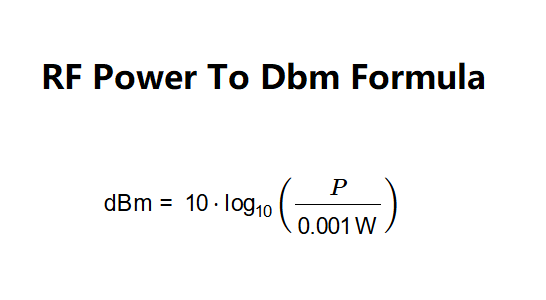 Home
Home
 Back
Back

Definition: This calculator converts RF power (P) into dBm, a unit of power expressed in decibels relative to 1 milliwatt (mW).
Purpose: It is used in RF engineering, telecommunications, and electronics to express power levels in a logarithmic scale, which is more convenient for handling a wide range of power values.
dBm is calculated using:
Power conversions:
Explanation: The input power is converted to watts, then the ratio \(P / 0.001 \, \text{W}\) is computed, and the result is scaled using the logarithmic formula to get the power in dBm. The reference power of 0.001 W (1 mW) is standard for dBm calculations.
Details: dBm is widely used in RF systems because it simplifies calculations involving power gains, losses, and signal levels, especially in antennas, amplifiers, and communication systems.
Tips: Enter the RF power (P) in W, mW, or µW (power must be greater than 0). The result will be the power level in dBm.
Examples:
Q: What does a negative dBm value mean?
A: A negative dBm value indicates that the power is less than 1 mW. For example, -30 dBm means the power is 0.001 mW (1 µW), which is 1000 times smaller than 1 mW.
Q: Why is the power not allowed to be zero?
A: The formula involves taking the logarithm of the power ratio, and the logarithm of zero is undefined in mathematics.
Q: Can I use this calculator for dBW instead of dBm?
A: No, this calculator is designed for dBm (reference 1 mW). For dBW, the reference power is 1 W, so the formula would be \( \text{dBW} = 10 \cdot \log_{10}\left(\frac{P}{1 \, \text{W}}\right) \), which requires a different calculator.
Q: What is the significance of the factor 10 in the formula?
A: The factor 10 is used because decibels are defined as ten times the logarithm (base 10) of a power ratio. This scaling makes the decibel unit practical for measuring a wide range of power levels.
Q: How do I interpret a dBm value of 0 dBm?
A: A dBm value of 0 dBm means the power is exactly 1 mW, as \( 10 \cdot \log_{10}(1) = 0 \). A value of 30 dBm means 1 W (1000 mW), and -30 dBm means 1 µW (0.001 mW).